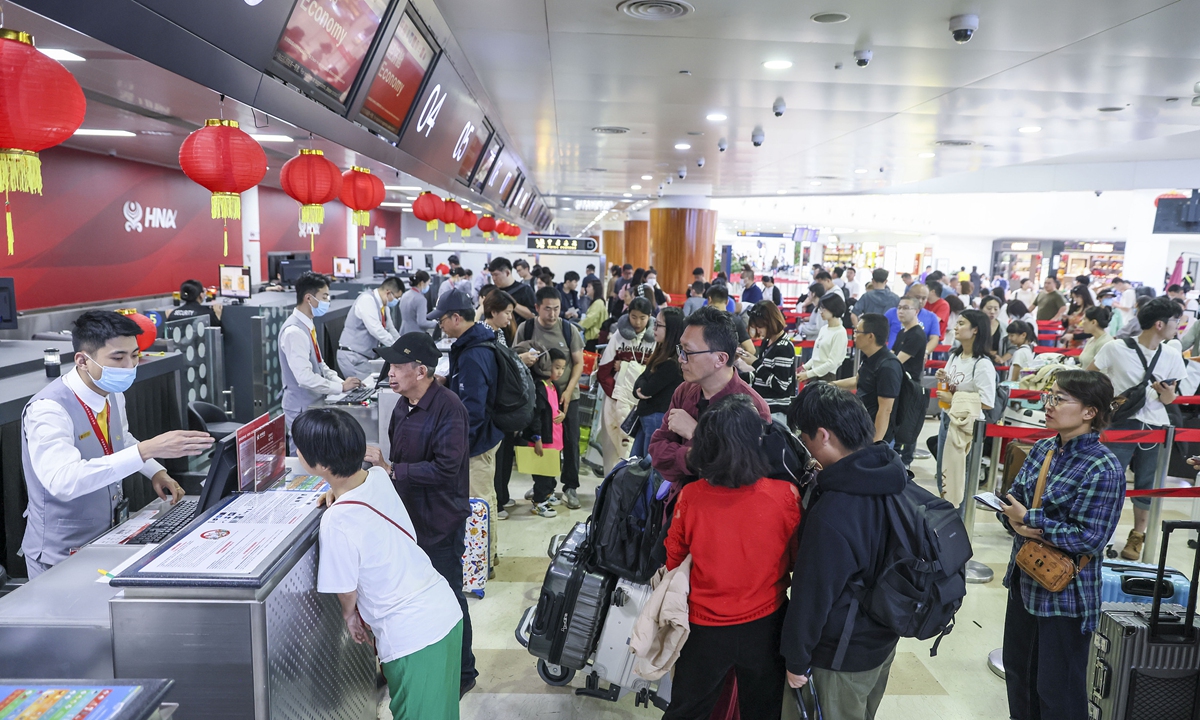Record figures point to robust holiday travel, spending during Chinese Lunar New Year

Tourists crowd the Hongyadong scenic area in Chongqing on February 12, 2024. Photo: VCG
A growing number of indicators, including record numbers of passenger trips and box office revenue during the Chinese Lunar New Year holidays, which ended on Saturday, highlighted a bustling holiday travel and consumption peak in China, continuing a tourism boom since the beginning of 2024 that has lifted expectations for China's economic recovery.
Record numbers of passenger trips during the annual Chunyun, the Chinese Lunar New Year travel rush which is often described as the largest human migration in the world, and robust growth in spending, from flights to movie tickets, underscore the vitality of the Chinese economy, and will form a solid foundation for China's continued economic recovery in 2024, according to experts.
Bustling holidays
On Saturday - the last day of the Chinese Lunar New Year holidays this year - alone, China's rail network is expected to carry 16.2 million passenger trips, with 2,256 additional trains dispatched to meet the surging demand, lifting the total capacity during Chunyun to a fresh record, China Railway said on Saturday.
On Friday, about 15.29 million passenger trips were made on the country's rail network, setting a new record for daily passenger volume during Chunyun for a third consecutive day, according to the state rail operator.
In total, between February 10 and Saturday, more than 2.31 billion passenger trips are expected to have been made on China's transport systems, including more than 2.18 billion trips on roads, according to official data. During the 40-day Chunyun period, about 9 billion passenger trips are expected, also setting a new record, officials said.
Underscoring the robust holiday travel, South China's Hainan Province, a traditional tourist hotspot, had to add additional flights to carry tourists home after ticket prices skyrocketed and many were unable to buy return tickets.
"Tourism has been indeed relatively more robust this year," Yang Yong, deputy director of the College of Economics and Management at East China Normal University, told the Global Times on Saturday, noting that the way Chinese people travel and consume during the holidays has changed a lot since 2019 due to the COVID-19 pandemic.
Yang said that one significant change is the rise of family travels during the holidays. "This year, people are actually spending more on family travel. In fact, family travel has become more obvious in recent years."
Wang Liping, a resident of Shanghai, said that his family of three joined other four families on a trip to Guangzhou and Shunde in South China's Guangdong Province during the holidays, with a main focus on the local delicacies.
"Due to the past pandemic, everyone is particularly keen on traveling now," Wang told the Global Times on Saturday.
While a final tally of consumption during the Lunar New Year holidays is yet available as of press time on Saturday, many localities and industries have reported robust figures. Most notably, China's box office revenue during the Lunar New Year holidays exceeded 8 billion yuan as of press time on Saturday, hitting a fresh record, according to Chinese ticketing platform Maoyan.
Meanwhile, the capital Beijing saw robust holiday spending. Major department stores, supermarkets, gift shops and catering and e-commerce firms, which were surveyed, generated a combined sales revenue of 7.74 billion yuan, up 36.8 percent from that of during the holidays in 2023, and up 64.1 percent from 2019, according to the Beijing Municipal Bureau of Commerce on Saturday.
In Southwest China's Sichuan Province, which has also become increasingly popular among travelers, top scenic spots within the province received about 5.38 million visitors and generated ticket sales revenue of more than 62.53 million yuan, up 25.74 percent and 32.63 percent year-on-year, respectively, according to local official data.
Boosting economy
The rebound in consumer spending is crucial for China's overall economic recovery, as consumption has become the biggest growth driver. In 2023, for instance, final consumption contributed 82.5 percent of total GDP growth for the year, according to official data. In terms of contribution to the growth rate, final consumption lifted the economic growth rate by 4.3 percentage points, 3.1 percentage points higher than in 2022.
Tian Yun, a Beijing-based economist, said that the recovery in consumption will continue to pick up pace and will remain the biggest driver of economic growth in 2024.
"More importantly, we need to pay more attention to the sustainability of the recovery in consumption," Tian told the Global Times on Saturday, noting if retail sales, a main indicator of consumption, retain a growth rate of above 6 percent in March and April, which would be more telling because the pandemic basically ended around the period in 2023, it would be a very powerful driving force for economic recovery.
In 2023, China's retail sales of consumer goods climbed 7.2 percent year-on-year, hitting 47.15 trillion yuan, according to official data. In December alone, retails sales jumped 7.4 percent.
If the robust consumption trend seen in the first two months continues, its contribution to the GDP growth rate will be above 4 percentage points, "which is necessary, if we are to strive for a GDP growth rate of 5 percent or more," Tian said, noting that with soaring spending, consumption could even lift the GDP growth rate by as much as 5 percentage points.
China is slate to set a slew of development targets, including the GDP growth rate, during the upcoming annual two sessions, which is scheduled to kick off in early March. Though facing various challenges, including a global economic downturn, some economists argue that the Chinese economy could grow 5 percent or more.




